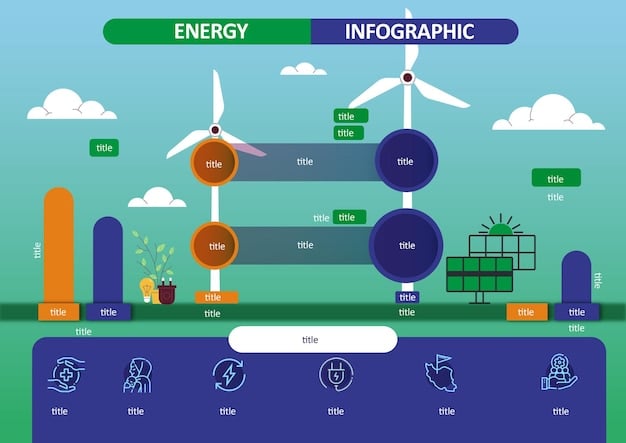US Energy Policy: A Renewable Energy Transition Roadmap

The Future of US Energy Policy: Navigating the Transition to Renewable Energy Sources requires a multifaceted approach, encompassing policy reforms, technological innovation, and substantial investments in renewable energy infrastructure to achieve a sustainable and secure energy future.
The **Future of US Energy Policy: Navigating the Transition to Renewable Energy Sources** demands a comprehensive understanding of current challenges and opportunities. How can the United States effectively shift towards a cleaner, more sustainable energy future?
The Imperative for Renewable Energy Transition
The United States faces a critical juncture in its energy policy, driven by growing concerns about climate change, energy security, and economic competitiveness. The transition to renewable energy sources is no longer a matter of choice but an environmental, economic and social necessity.
Drivers of Change
Several factors are coalescing to accelerate the shift towards renewable energy. These include increasing public awareness of climate change, declining costs of renewable technologies, and policy initiatives aimed at promoting clean energy.
Environmental Concerns
The detrimental effects of fossil fuels on the environment are well-documented, ranging from air and water pollution to greenhouse gas emissions that contribute to global warming. Shifting to renewables can mitigate these impacts significantly.

To delve deeper into the drivers and concerns of the field, there are a few keypoints worth noting:
- Climate Change Mitigation: Reducing carbon emissions is critical to averting the worst impacts of climate change.
- Energy Security: Diversifying energy sources reduces dependence on volatile global fossil fuel markets.
- Economic Opportunities: The renewable energy sector offers significant potential for job creation and technological innovation.
The growing environmental concerns, combined with increased public awareness and the reality of global change call for new and innovative methods to generate energy.
Current US Energy Policy Landscape
The current US energy policy landscape is a complex mix of federal and state regulations, incentives, and mandates. These policies have a significant impact on the development and deployment of renewable energy technologies.
Federal Policies
Federal policies, such as tax credits for renewable energy production and investment, play a crucial role in leveling the playing field for clean energy technologies. However, these policies can be subject to political shifts and uncertainty.
State Policies
State-level policies, such as Renewable Portfolio Standards (RPS), mandate that a certain percentage of electricity must come from renewable sources. These standards vary widely across states, creating a patchwork of different regulatory environments.

Here are some things to consider regarding federal and state level polices:
- Tax Credits: Incentivize renewable energy production and investment.
- Renewable Portfolio Standards (RPS): Mandate a percentage of electricity from renewables.
- Energy Efficiency Standards: Reduce overall energy consumption.
In order to further understand the dynamics of change, one needs to dive into the complexities of policy implementation and the consequences it brings about. All types of energy are subject to specific legislature.
Challenges in Renewable Energy Transition
Despite the growing momentum behind renewable energy, several challenges remain in the transition process. These challenges include technological limitations, infrastructure constraints, and policy barriers.
Technological Limitations
Renewable energy sources, such as solar and wind, are intermittent, meaning they depend on weather conditions. This intermittency requires energy storage solutions, such as batteries or pumped hydro, to ensure a reliable power supply.
Infrastructure Constraints
The existing transmission infrastructure is not always adequate to transport electricity from renewable energy sources to population centers. Upgrading and expanding the grid is essential to accommodate the increasing share of renewables.
Renewable energy is not without its limitations. As a developing form of energy, there will always be things to improve upon, such as:
- Intermittency: Solar and wind depend on weather conditions.
- Grid Infrastructure: Upgrading transmission lines is essential.
- Energy Storage: Developing cost-effective storage solutions.
Despite the best efforts to overcome these limitations, it is essential to understand the true cost of implementing new energy solutions. Sometimes, it is more costly than it seems.
Policy Recommendations for a Sustainable Energy Future
To overcome the challenges and accelerate the transition to renewable energy, several policy recommendations can be considered. These recommendations focus on creating a supportive regulatory environment, promoting technological innovation, and investing in infrastructure.
Incentivizing Renewable Energy
Providing long-term, stable tax credits and other incentives can encourage investment in renewable energy projects. These incentives should be technology-neutral to allow for competition between different renewable sources.
Modernizing the Grid
Investing in grid modernization is essential to accommodate the increasing share of renewable energy. This includes upgrading transmission lines, deploying smart grid technologies, and promoting energy storage solutions.
To help promote a sustainable future with energy, it is important to focus on:
- Long-Term Tax Credits: Encourage investment in renewable energy.
- Grid Modernization: Upgrade transmission lines and deploy smart grid technologies.
- Research and Development: Support innovation in energy storage and other technologies.
As new technologies are refined and modernized, the overall efficiency of the energy grid will continue to improve. One thing is certain – research and investigation must be a critical component.
The Role of Technology in Energy Transition
Technology plays a critical role in advancing the renewable energy transition. Innovations in energy storage, smart grids, and renewable energy generation are essential for achieving a sustainable energy future.
Energy Storage
Advanced battery technologies, such as lithium-ion batteries, are becoming more cost-effective and can store energy for later use. Other storage solutions, such as pumped hydro and compressed air energy storage, are also gaining traction.
Smart Grids
Smart grids use digital technology to monitor and manage the flow of electricity, improving efficiency and reliability. They can also integrate distributed energy resources, such as rooftop solar panels, into the grid.
New technologies, like the following, are integral for the energy sector:
- Advanced Batteries: Store energy for later use.
- Smart Grids: Improve efficiency and reliability of electricity flow.
- Renewable Energy Generation: Increase efficiency and reduce costs of solar, wind, and other technologies.
All new forms of technology must be researched, evaluated and refined to contribute to the best version of new-aged solutions.
International Collaboration and US Energy Policy
International collaboration is essential for addressing global energy challenges and promoting the adoption of renewable energy technologies. The United States can play a leadership role in this effort.
Sharing Best Practices
The United States can share its experiences and best practices in renewable energy policy and deployment with other countries. This can help accelerate the transition to clean energy worldwide.
International Agreements
Participating in international agreements, such as the Paris Agreement, signals a commitment to addressing climate change and promoting sustainable energy policies. This can encourage other countries to take similar action.
International collaboration can bring about many benifits, and it is good to focus on the following:
- Sharing Best Practices: Facilitate knowledge transfer and accelerate the transition.
- International Agreements: Signal commitment to addressing climate change.
- Collaborative Research: Advance technological innovation.
Working together as a global community will create new possibilities that benefit everyone, especially in the face of global energy challenges.
| Key Point | Brief Description |
|---|---|
| ☀️ Renewable Energy Transition | Necessity for environmental, economic, and social reasons. |
| ⚡ Policy Recommendations | Incentivize renewables, modernize the grid, and support R&D. |
| 🤝 International Collaboration | Share best practices and participate in agreements. |
| 💡 Technological Innovation | Advances in energy storage and smart grids are crucial. |
Frequently Asked Questions
▼
The main drivers include increasing climate change awareness, the decreasing cost of renewable technologies, and policies promoting clean energy. All these are the backbone of a new system.
▼
Federal policies, such as tax credits, incentivize renewable energy production, while state policies, like Renewable Portfolio Standards (RPS), mandate a percentage of electricity from renewables.
▼
Challenges include the intermittency of renewable sources, the need for grid infrastructure upgrades, and the development of cost-effective energy storage solutions, as a few fundamental examples.
▼
Providing long-term, stable tax credits and technology-neutral incentives can encourage investment in renewable energy projects, helping bring about necessary long-term projects.
▼
International collaboration allows for the sharing of best practices, participation in international agreements, and collaborative research to advance technological innovation, thereby benefitting everyone.
Conclusion
The Future of US **Energy Policy: Navigating the Transition to Renewable Energy Sources** requires a concerted effort from policymakers, industry, and individuals. By embracing technological innovation, implementing supportive policies, and fostering international collaboration, the United States can achieve a sustainable and secure energy future for generations to come.





